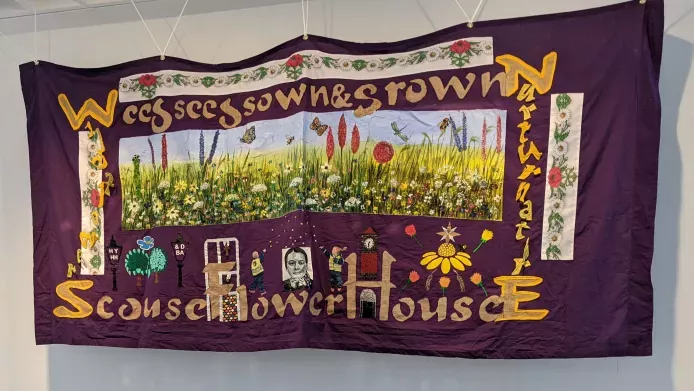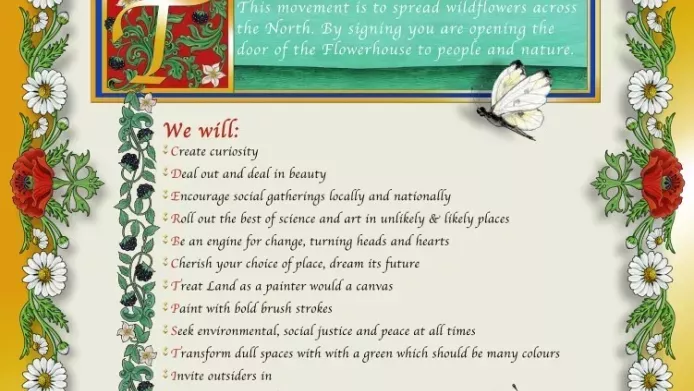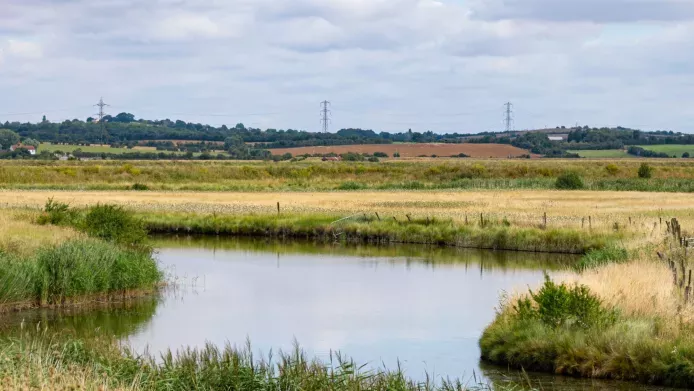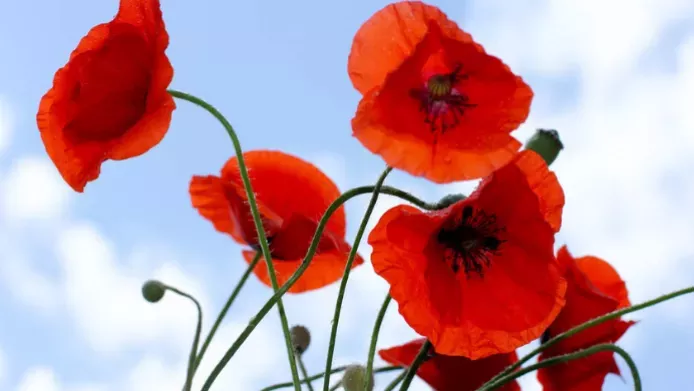In 2014, Grow Wild awarded The National Wildflower Centre (now part of the Eden Project) a flagship grant for their project, A Tale of Two Cities. Richard Scott reflects on the project, recounting how wildflowers have become emblems of possibility and joy for communities in Liverpool and Manchester, bringing people together to sow seeds and transform lives.
I became interested in meadows as a teenager. It was initially a few hidden gems where I grew up in Lincolnshire (once the meadow county) that caught my imagination, but sadly few of these meadows remain now. I never saw anyone else when I went to the cowslip meadow at Sotby, which seemed such a great shame.
I remember Iain Parkinson (Wakehurst Head of Landscape & Horticulture) being impressed when I showed him places like Sotby meadow and Little Scrub’s meadow. Over 20 years ago, with a permit, we collected devil’s-bit seed for a special creative conservation project at Woolfall Heath in Knowsley, Liverpool. What started as ten grammes of devil’s-bit scabious seed now grows in a dense purple haze amongst other species. The plants cover an area of about two hectares and are a testimony to what is possible when seeds are sown wisely, with good ground preparation and awareness of the soil dynamic.
When the Royal Botanic Gardens, Kew announced their Grow Wild competition for an England Flagship award in 2014, I knew The National Wildflower Centre had to win it. The flagship campaign offered four high-profile grants to programmes in England, Wales, Scotland and Northern Ireland, funding community-led activities focused on the preservation and promotion of UK native plants.

At The National Wildflower Centre, we wanted to make a bold statement, practicing a new kind of cultural ecology to raise the bar in terms of possibility. We wanted to use the funding to celebrate the possibility of wildflowers, as ‘A Tale of Two Cities’, linking Liverpool and Manchester. Our aims were to celebrate wildflower culture and ecology, respect the legacies and the lives of those who have lived there, and look forward to better environmental futures.
With brilliant support from communities in Everton (The Friends Everton Park) and Hulme (such as Hulme Community Garden Centre), we beat six competing cities and substantially won a National Lottery public vote for two great but often rival cities. This meant we had £120,000 to highlight nature and culture through wildflowers, bringing nature home to two communities that have witnessed upheavals, demolitions, dispersal and diaspora.
'The project intended to have a bold approach - this is what has kept it alive six years later in the hearts and souls of Liverpool and Manchester'

In naval terms a ‘flagship’ provides signals to its fleet, and although we are not sailors at The National Wildflower Centre, we have found new ways of signaling the possibilities of using seed. Most recently, we have been proud to work closely with the famous Liverpool FC ‘craftivist’ and survivor of the 1989 Hillsborough disaster, Peter Carney. Working with Peter and artist Ling Warlow in school workshops across the city, we filled pockets on the Hillsborough Memorial Banner with paper wildflowers made by children. This banner was displayed nationally and now internationally, including as part of “The Beautiful Game” exhibition at the Design Museum in London. Peter also produced a Weeds for Wildflower banner for us, which he calls his ‘lockdown comfort blanket’, which has become a kind of talisman for our work.

Since 2014 we have incrementally sown new plants in Everton Park, and news of the project has travelled. Acclaimed nature writer Robert MacFarlane walked the viewpoint in Everton Park in 2017 and held a Lost Words workshop with local children. In 2022 Everton Park was chosen as a location for the Red Ball International Art Project. Imagery from this has been shared, with the site receiving visits from famous gardeners like Fergus Garrett, community groups and ecologists as far as Tokyo. The project intended to have a bold approach - this is what has kept it alive six years later in the hearts and souls of Liverpool and Manchester.
In 2022 The Friends of Everton Park and Everton Community Garden collected 3kg of Cowslip seed from the Everton slopes to plant across the city. Seeds have already been sown in Toxteth as well as a pioneering carbon capture meadow in Calderstones, a park which was a part of John Lennon’s childhood and close to the real Strawberry Fields. As A Tale of Two Cities continues to evolve, we have returned to Manchester, creating vibrant areas throughout the city in Moss Side, Rusholme and Whalley Range. It’s a far cry from a secluded meadow in Lincolnshire, but this project aims to highlight a different story and the beauty of connecting the rural and urban.
'The National Wildflower Centre delights in the word culture, how ecology breaks down cultural divides and in the simplicity of sowing seeds which bring flowers, colour, bees, butterflies, and joy.'
Everton Park has been a catalyst for an explosion of wildflowers across Liverpool, creating garden communities everywhere, uniting wildflower “hotspots”, and year on year finding new and creative ways to carry on. The fun and energy of our initial project has rippled through the region such as with Scouse Flowerhouse, which emerged from Liverpool City Council’s commitment to Wildflower Gateways as a holistic way of addressing climate change across the city, as well as the Northern Flowerhouse Charter as decorated by international artists the Singh Twins. The National Wildflower Centre delights in the word culture, how ecology breaks down cultural divides and in the simplicity of sowing seeds which bring flowers, colour, bees, butterflies, and joy. This year we want to continue the project’s evolution, creating linkages to music through new commissions, as Liverpool hosts the 2023 Eurovision Song Contest.

Although we have entered 2023 with challenges such as budget cuts and stretched resources, the Tale of Two Cities says so much about what can be achieved with gusto and chutzpah. Manchester Councillor Lee-Ann Igban was initially skeptical of our enthusiasm but is now Executive Member for Vibrant Neighborhoods and in a recent Manchester City Council Report said, “The wildflowers were absolutely a turning point”. This project work offers an important example as the debate grows around the delivery of Natural England’s ‘Biodiversity Net Gain’ plan, which aims to retain and create more wildlife habitats in the UK.
'The wildflowers were absolutely a turning point'
Football has always been an important part of the narrative for A Tale of Two Cities, it was Liverpool FC legend, Sir Kenny Danglish (aka ‘King Kenny’), who helped tip the 2014 vote in our favour when he tweeted his support for the project. In places like Everton and Anfield large numbers of people travel to matches through places we have sown seeds. It is important to note how these connections between society and biodiversity multiply as part of a new Scouse Flowerhouse. The number of people who tragically lost their lives at Hillsborough is 97, the same percentage of meadows that have been lost since the 1930’s (source; Royal Botanic Gardens, Kew, 2017). These connected losses represent a serious debate in terms of the environmental and social justice that connects people to fair societies and better surroundings. As football fans walk past banks of cowslips in Everton in the Spring, I think of uniting lonely meadows to protect our cities, providing hope and evidence of fairer and more inclusive futures.
'No flower should walk alone'
The UK has the worst biodiversity of all the G7 nations (source; RSPB, 2021), causing urban and rural people to be starved of a rich natural environment. In the manner of David Hockney, let’s strive to create ‘a bigger splash’. Seeds can be more than a metaphor; sown well in the right soil, with the right management, we can combine climate and biodiversity action with joy, love, and celebration. Giving wildflowers a chance can be simply freeing them from council mowers. These glorious landscapes deserve love; people deserve to see these spaces and know where to find them. This is possible when done in imaginative ways that reflect nature as part of culture.
The tale continues. No flower should walk alone; they have champions everywhere. They should decorate our pathways in life, our greenspaces, our parks, and the countryside. With management and bold intervention, they can be part of a brighter and beautiful ecological future.

Thanks to all who supported and delivered this project with us, particularly Polly Moseley, who produced and curated the cultural links with such imagination with artists and musicians, The Friends of Everton Park and Liverpool City Council and Councillors. Dave Barlow at Manchester City Council, Sean Harkin, then Manchester’s Gardener in residence with the National Trust, and Hulme Community Garden Centre.
More from the Grow Wild blog


